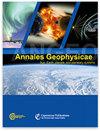Estimating gradients of physical fields in space
IF 1.9
4区 地球科学
Q3 ASTRONOMY & ASTROPHYSICS
引用次数: 0
Abstract
Abstract. This study focuses on the development of a multi-point technique for future constellation missions, aiming to measure gradients at various orders, in particular the linear and quadratic gradients, of a general field. It is well established that, in order to estimate linear gradients, the spacecraft must not lie on a plane. Through analytical exploration within the framework of least squares, it is demonstrated that at least 10 spacecraft that do not lie on any quadric surface are required to estimate both linear and quadratic gradients. The spatial arrangement of the spacecraft can be characterized by a set of quality factors. In cases where there is poor temporal synchronization among the spacecraft leading to non-simultaneous measurements, temporal gradients must be included. If the spacecraft have multiple velocities, by incorporating temporal gradients it is possible to reduce the number of required spacecraft. Furthermore, it is proved that the accuracy of the linear gradient is of second order and that of the quadratic gradient is of first order. Additionally, a method for estimating errors in the calculation is also illustrated.估算空间物理场的梯度
摘要本研究的重点是为未来的星座任务开发一种多点技术,旨在测量一般场的各种阶梯梯度,特别是线性和二次梯度。众所周知,为了估算线性梯度,航天器必须不在一个平面上。通过在最小二乘法框架内进行分析探索,证明至少需要 10 个不位于任何二次曲面上的航天器才能估算出线性梯度和二次梯度。航天器的空间排列可以用一组质量因素来表征。如果航天器之间的时间同步性差,导致测量不同步,则必须将时间梯度包括在内。如果航天器有多个速度,则可以通过加入时间梯度来减少所需的航天器数量。此外,还证明了线性梯度的精度是二阶的,而二次梯度的精度是一阶的。此外,还说明了一种估算计算误差的方法。
本文章由计算机程序翻译,如有差异,请以英文原文为准。
求助全文
约1分钟内获得全文
求助全文
来源期刊

Annales Geophysicae
地学-地球科学综合
CiteScore
4.30
自引率
0.00%
发文量
42
审稿时长
2 months
期刊介绍:
Annales Geophysicae (ANGEO) is a not-for-profit international multi- and inter-disciplinary scientific open-access journal in the field of solar–terrestrial and planetary sciences. ANGEO publishes original articles and short communications (letters) on research of the Sun–Earth system, including the science of space weather, solar–terrestrial plasma physics, the Earth''s ionosphere and atmosphere, the magnetosphere, and the study of planets and planetary systems, the interaction between the different spheres of a planet, and the interaction across the planetary system. Topics range from space weathering, planetary magnetic field, and planetary interior and surface dynamics to the formation and evolution of planetary systems.
 求助内容:
求助内容: 应助结果提醒方式:
应助结果提醒方式:


